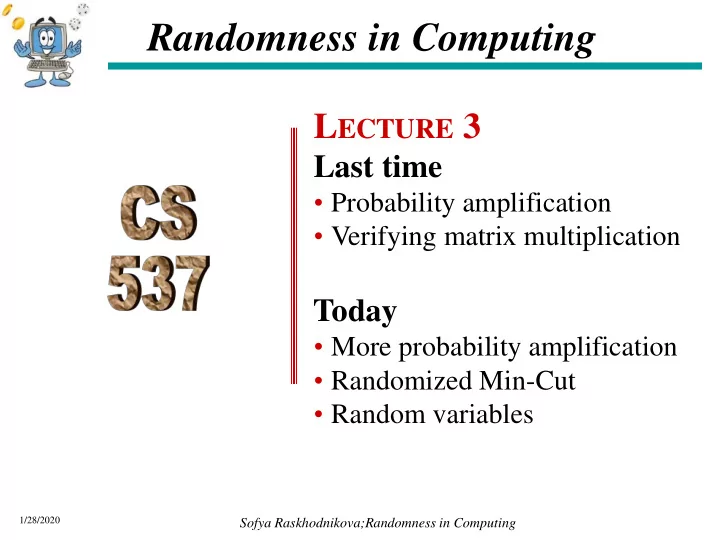

Randomness in Computing L ECTURE 3 Last time • Probability amplification • Verifying matrix multiplication Today • More probability amplification • Randomized Min-Cut • Random variables 1/28/2020 Sofya Raskhodnikova;Randomness in Computing
Review question: balls and bins We have two bins with balls. • Bin 1 contains 3 black balls and 2 white balls. • Bin 2 contains 1 black ball and 1 white ball. We pick a bin uniformly at random. Then we pick a ball uniformly at random from that bin. What is the probability that we picked bin 1, given that we picked a white ball? 1/28/2020 Sofya Raskhodnikova; Randomness in Computing
Bayesian Approach to Amplification How does our confidence increase with the number of trials? • C = event that identity is correct • A = event that test accepts Our analysis of Basic Frievalds: • Pr[A| 𝐷 ] ≤ 1/2 • 1-sided error: Pr[A|C]=1 Assumption (initial belief or ``prior’’): Pr 𝐷 = 1/2 By Bayes’ Law Pr 𝐵 𝐷 ⋅ Pr 𝐷 Pr 𝐷 𝐵 = Pr 𝐵 𝐷 ⋅ Pr 𝐷 + Pr 𝐵 𝐷 ⋅ Pr 𝐷 1 ⋅ 1 = 2 2 ≥ 1 ⋅ 1 2 + 1 2 ⋅ 1 3 2 1/28/2020 Sofya Raskhodnikova; Randomness in Computing
Bayesian Approach to Amplification How does our confidence increase with the number of trials? • C = event that identity is correct • A = event that test accepts Our analysis of Basic Frievalds: • Pr[A| 𝐷 ] ≤ 1/2 • 1-sided error: Pr[A|C]=1 Assumption (initial belief or ``prior’’): Pr 𝐷 = 𝟑/𝟒 By Bayes’ Law Pr 𝐵 𝐷 ⋅ Pr 𝐷 Pr 𝐷 𝐵 = Pr 𝐵 𝐷 ⋅ Pr 𝐷 + Pr 𝐵 𝐷 ⋅ Pr 𝐷 1 ⋅ 𝟑 = 𝟓 𝟒 ≥ 1 ⋅ 𝟑 𝟒 + 1 2 ⋅ 𝟐 𝟔 𝟒 1/28/2020 Sofya Raskhodnikova; Randomness in Computing
Bayesian Approach to Amplification How does our confidence increase with the number of trials? • C = event that identity is correct • A = event that test accepts Our analysis of Basic Frievalds: • Pr[A| 𝐷 ] ≥ 1/2 • 1-sided error: Pr[A|C]=1 Assumption (initial belief or ``prior’’): Pr 𝐷 = 𝟑 𝒋 /(𝟑 𝒋 + 𝟐) By Bayes’ Law Pr 𝐵 𝐷 ⋅ Pr 𝐷 Pr 𝐷 𝐵 = Pr 𝐵 𝐷 ⋅ Pr 𝐷 + Pr 𝐵 𝐷 ⋅ Pr 𝐷 𝟑 𝒋 1 ⋅ 𝟑 𝒋+𝟐 𝟑 𝒋 + 𝟐 ≤ = 𝟑 𝒋+𝟐 + 𝟐 𝟑 𝒋 𝟑 𝒋 + 𝟐 + 1 𝟐 1 ⋅ 2 ⋅ 𝟑 𝒋 + 𝟐 1/28/2020 Sofya Raskhodnikova; Randomness in Computing
§ 1.5 (MU) Randomized Min Cut Given: undirected graph 𝐻 = (𝑊, 𝐹) A global cut of 𝐻 is a partition of 𝑊 into non-empty, disjoint sets S, T. The cutset of the cut is the set of edges that connect the parts: 𝑣, 𝑤 𝑣 ∈ 𝑇, 𝑤 ∈ 𝑈} Goal: Find the min cut in 𝐻 (a cut with the smallest cutset). T S Applications: Network reliability, network design, clustering Exercise: How many distinct cuts are there in a graph 𝐻 with 𝑜 nodes? 1/28/2020 Sofya Raskhodnikova; Randomness in Computing
Min Cut Algorithms Given: undirected graph 𝐻 = (𝑊, 𝐹) with 𝑜 nodes and 𝑛 edges. Goal: Find the min cut in 𝐻 . Algorithms for Min Cut: 𝑃(𝑛𝑜 + 𝑜 2 log 𝑜) time • Deterministic [Stoer-Wagner `97] 𝑃(𝑜 2 𝑛 log 𝑜) time • Randomized [Karger `93] but there are improvements 1/28/2020 Sofya Raskhodnikova; Randomness in Computing
§ 1.5 (MU) Karger’s Min Cut Algorithm Idea: Repeatedly pick a random edge and put its endpoints on the same side of the cut. Basic operation: Edge contraction of an edge 𝒗, 𝒘 • Merge 𝑣 and 𝑤 into one node • Eliminate all edges connecting 𝑣 and 𝑤 • Keep all other edges, including parallel edges (but no self-loops) 𝒗 𝒘 Claim A cutset of the contracted graph is also a cutset of the original graph . 1/28/2020 Sofya Raskhodnikova; Randomness in Computing
§ 1.5 (MU) Karger’s Min Cut Algorithm (input: undirected graph 𝐻 = (𝑊, 𝐹) Algorithm Basic Karger While 𝑊 > 2 1. choose 𝑓 ∈ 𝐹 uniformly at random 2. 𝐻 ← graph obtained by contracting 𝑓 in 𝐻 3. Return the only cut in 𝐻. 4. Theorem 2 Basic-Karger returns a min cut with probability ≥ 𝑜(𝑜−1) . Probability Amplification: Repeat 𝑠 = 𝑜 𝑜 − 1 ln 𝑜 times and return the smallest cut found. Running time of Basic Karger: Best known implementation: O 𝑛 • Easy: 𝑃(𝑛) per contraction, so 𝑃(𝑛𝑜) • View as Kruskal’s MST algorithm in 𝐻 with 𝑥 𝑓 𝑗 = 𝜌(𝑗) run until two components are left: 𝑃(𝑛 log 𝑜) 1/28/2020 Sofya Raskhodnikova; Randomness in Computing
Measurements in random experiments • Example 1: coin flips – Measurement X: number of heads. – E.g., if the outcome is HHTH, then X=3. • Example 2: permutations – 𝑜 students exchange their hats, so that everybody gets a random hat – Measurement X: number of students that got their own hats. – E.g., if students 1,2,3 got hats 2,1,3 then X=1. 1/28/2020
Random variables: definition • A random variable X on a sample space Ω is a function 𝑌: Ω → ℝ that assigns to each sample point 𝜕 ∈ Ω a real number 𝑌 𝜕 . • For each random variable, we should understand: – The set of values it can take. – The probabilities with which it takes on these values. • The distribution of a discrete random variable X 𝑏, Pr 𝑌 = 𝑏 . is the collection of pairs 1/28/2020
Recommend
More recommend